Victoria Police
Victoria Police is the primary law enforcement agency of the Australian state of Victoria. It was formed in 1853 and currently operates under the Victoria Police Act 2013.[2][6][7]
| Victoria Police | |
|---|---|
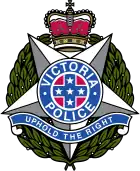 Badge of the Victoria Police | |
 Flag of the Victoria Police | |
| Motto | Uphold the Right "Tenez le Droit" until November 1986 |
| Agency overview | |
| Formed | 8 January, 1853 |
| Employees | 21,399 (December 2019)[1][2] |
| Annual budget | A$3.70 billion (2021–22)[2] |
| Jurisdictional structure | |
| Operations jurisdiction | |
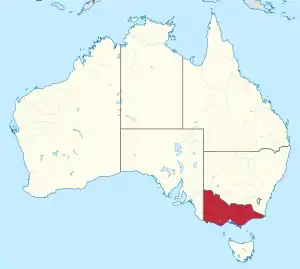 | |
| Victoria Police jurisdiction | |
| Size | 237,659 square kilometres |
| Population | 6,689,377 |
| Legal jurisdiction | As per operations jurisdiction |
| Governing body | Government of Victoria |
| Constituting instrument |
|
| General nature | |
| Operational structure | |
| Overviewed by | Independent Broad-based Anti-corruption Commission |
| Headquarters | Victoria Police Centre 311 Spencer Street Docklands37.814122°S 144.951615°E |
| Sworn officers | 16,700 (May 2022)[1][2] |
| Minister responsible |
|
| Agency executive | |
| Units | List
|
| Regions | Western, Eastern, North West Metro, Southern Metro[5] |
| Facilities | |
| Stations | 333 (2019), 185 police residences, 96 other facilities |
| Website | |
| police.vic.gov.au vicpolicenews.com.au | |
As of May 2022, Victoria Police had over 22,300 staff, comprising over 16,700 police officers, 1,490 Protective Services Officers, 390 Police Custody Officers and 253 Police Recruits in training, 2 reservists and 3750 Victorian Public Service (VPS) employees across 333 police stations. It had a budget of A$3.76 billion.[2]
Between 31 July 2018 and 18 July 2019, Victoria Police recorded 514,398 offences, an increase of 1.5% from the previous year.[8] Victoria Police also responded to 897,016 emergency calls, a reduction of 0.3% from previous year.[2]
History
Background
A couple of years after the first Europeans settled there, in September 1836 the area around Melbourne, known as the District of Port Phillip, became part of the colony of New South Wales. From 1851 until 1901 it became the Colony of Victoria, with its own government within the British Empire. In 1901 it became a state of the new Commonwealth of Australia.[9]
Early history
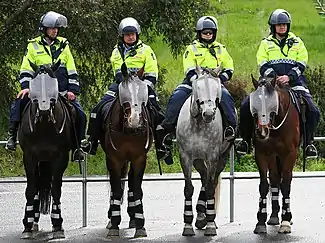
The early settlers of Melbourne provided their own police force, and in 1840 there were 12 constables who were paid two shillings and nine pence per day, and the chief constable was Mr. W (Tulip) Wright.[10] Charles Brodie followed Wright as chief constable in 1842 and was succeeded by W. J. Sugden, who held the positions of 'town chief constable' and superintendent of the local fire brigade.[10] By 1847, there were police in 'country centres', and the Melbourne force was composed of 'one chief officer, four sergeants, and 20 petty constables'.[10] There was also 'a force of 28 mounted natives' enlisted and trained by DeVilliers and, later, Captain Pulteney Dana.[10]
.jpg.webp)
The Snodgrass Committee was established in early 1852 to "identify the policing needs of the colony", and, following the committee's report in September 1852, the Victoria Police was formally established on 8 January 1853[11] from an existing colonial police force of 875 men. Later that month, William Henry Fancourt Mitchell was 'gazetted as Chief Commissioner of Police for the Colony of Victoria'.[12]
In 1853, Victoria Police was the first police organisation in Australia who merged all its police entities into one organisation under Victoria Police Chief Commissioner William Mitchell. Victoria continues to be the only state in Australia with a Chief Commissioner of Police.[13]
Their first major engagement was the following year, 1854, in support of British soldiers during the events leading up to, and confrontation at, the Eureka Stockade where some miners (mostly Irish), police and soldiers were killed. From a report at the time: 'the troops and Police were under arms, and just at the first blush of dawn they marched upon the camp at Eureka'.[14]
Mitchell resigned as Chief Commissioner, and Charles MacMahon was appointed acting chief commissioner that same year.[15] After the formation of the Victorian Police, the first recorded death on duty was Edward Gray in 1853, followed by William Hogan in 1854, both of drowning.[16]
The following couple of decades saw the growth of the police force, including the beginning of construction of the Russell Street police station in 1859.[17]

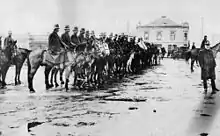
Six years later, three more officers (Kennedy, Lonigan and Scanlan) who were hunting the Kelly Gang, were killed by them at Stringybark Creek.[18][19] Two years later, in 1880, the police confronted the Kelly Gang at Glenrowan. A shoot-out ensued on 28 June, during which three members of the Kelly Gang were killed and following which Ned Kelly was shot and captured.[20]
In 1888, senior constable John Barry produced the first Victoria Police Guide, a manual for officers.[21] (The Victoria Police Manual, as it is now known, remains the comprehensive guide to procedure in the Victoria Police.) Police officers were granted the right to vote in parliamentary elections the same year.[22]
In 1899, the force introduced the Victoria Police Valour Award to recognise the bravery of members.[23] Three years later, in 1902, the right to a police pension was revoked.[24]
In October 1917, Victoria Police appointed Madge Connor as a 'police agent'—while not a full sworn officer, Connor was the first woman to be made a member of a police service in Victoria,[25] and was one of four women to be sworn in as officers in 1924, after she led a successful campaign for equal pay and status within the force.[26]
1923 Victoria Police strike
On 31 October 1923, members of the Victoria Police Force refused duty and went on strike over the introduction of a new supervisory system. The police strike led to riots and looting in Melbourne's central business district. The Victorian government enlisted special constables, and the Commonwealth of Australia called out the Australian military. Victoria Police are the only Australian Police Service to ever go on strike.
Only a few of the strikers were ever employed as policemen again, but the government increased pay and conditions for police as a result. Members of the Victoria Police (as its officers are generally known) now have among the highest union membership rates of any occupation, at well over 90%. Their union, Police Association Victoria, remains a very powerful industrial and political force in Victoria.
Recent history
In the 1980s and 1990s allegations were made against most Australian police forces of corruption and graft, culminating in the establishment of several Royal Commissions and anti-corruption watchdogs. Inquiries have also been held into Victoria Police (Beach et al.). The force was criticised because members of the public (both innocent and guilty) were being fatally shot at a rate exceeding that of all other Australian police forces combined.[27] Related criticisms emerged after the 2008 killing of Tyler Cassidy by Victoria Police officers, which was partly blamed on inadequate training. In later years, numerous edits were made to the Wikipedia article about the killing from police computers, in an attempt to give a more favourable impression of the officers' conduct and the subsequent investigation.[28]
In 2001, Christine Nixon was appointed Chief Commissioner, becoming the first woman to head a police force in Australia.
In May 2004 former police officer Simon Illingworth appeared on ABC-TV's Australian Story documentary program to tell his disturbing story of entrenched police corruption in Victoria Police. He has also written a book about his experiences entitled Filthy Rat.[29]
In early 2007, Don Stewart, a retired Supreme Court judge, called for a royal commission into Victorian police corruption. Stewart alleged that the force was riddled with corruption that the Office of Police Integrity was unable to deal with.[30]
On 2 March 2009, Simon Overland was named as the new chief commissioner, replacing Christine Nixon, who was retiring.[31] In June 2011, Overland announced his decision to resign prematurely with effect from 1 July 2011 over what many assume were the allegations of corruption, the ombudsman criticism and the government pressure.[32][33][34]
In November 2011, then acting chief commissioner Ken Lay was named as chief commissioner after five months' caretaking.
On 21 October 2011, the police force evicted Occupy Melbourne protesters from Melbourne City Square. Despite 173 arrests being made, no charges were laid against any protesters.[35]
On 29 December 2014, Lay announced he was stepping down as the chief commissioner of Victoria Police after three years of service, taking leave until his resignation took effect on 31 January 2015. Deputy chief commissioner Tim Cartwright was acting in the role until a new commissioner was appointed.[36] On 25 May 2015, Deputy Commissioner Graham Ashton of the Australian Federal Police was announced as the new chief commissioner—he took up the role in July 2015.[37]
In April 2016, the treasurer announced an investment of $586 million into Victoria Police. From this investment, $540 million was used to employ 406 additional sworn police officers and 52 additional specialist staff, technology upgrades and an expanded forensic capability of Victoria Police; $36.8 million to replace and refurbish a number of police stations in regional and rural areas; $19.4 million to continue the Community Crime Prevention Program; $63 million to enhance counter-terrorism capability, including an additional 40 sworn police officers; and 48 additional specialist staff to investigate and respond to an increased terror threat. The budget also funds a package of initiatives for all Victoria Police employees to help deal with mental health problems.[38]
In 2015, Victoria Police employed The Victorian Equal Opportunity and Human Rights Commission (VEOHRC) to examine the nature and prevalence of sex discrimination, including predatory behaviour, amongst Victoria Police personnel.[39] Kate Jenkins was appointed the Commissioner[39] and, in mid December 2015, VEOHRC revealed its findings.[40] Shortly after, on 9 December 2015, Victoria Police Chief Commissioner Ashton apologised over the high tolerance and prevalence of sexual harassment and the sexual discrimination and gender inequality within Victoria Police. Ashton pledged a change of direction and the implementation of all 20 recommendations by VEOHRC.[41]
In December 2016, Police Minister Lisa Neville announced the recruitment of 2,735 new Victoria Police officers, the largest in the organisation's history as part of Victoria's first Community Safety Statement.[42]
In September 2017, Transport Accident Commission (TAC) notified Victoria Police of "anomalies" in the preliminary breath tests statistics data. TAC and Victoria Police analyzed more than 17.1m tests starting February 2012 and found that 258,463, or less than 1.5% tests were probably false.[43] As a result, in mid 2018, TAC froze $4m funding to Victoria Police operations. Victoria Police also started an internal investigation into the matter, notified IBAC and appointed former chief commissioner Neil Comrie to conduct an investigation into the causes.[44] A preliminary report suggested that unrealistic management demands of between 50 and 100 breath tests per shift was a possible cause to faking the tests. The methods used by police officers was that of placing a finger over the straw entry hole of breath testing equipment or blowing into the straw themselves.[44]
In December 2018, Premier Daniel Andrews announced the Royal Commission into the Management of Police Informants to examine the actions of Victoria Police in their handling of Nicola Gobbo who informed on her clients whilst working as a barrister.[45][46] The commission was established following the High Court delivering their decision in AB v CD; EF v CD in November 2018 in which they found Victoria Police to be "guilty of reprehensible conduct".[47]
Uniform
Between 1853 and 1877, when the first Victoria Police officers emerged, the uniforms resembled the military style of the day. Mounted and foot officers wore dark blue jackets buttoned to the neck. Mounted troops wore swords whilst the Gold Escorts carried revolvers and rifles. The foot patrols, as equipment, had wooden batons, notebooks, handcuffs and a whistle to call for assistance when in need. The whistles were fixed to the officer tunic by chain which prevented losing the whistle or falling during a foot chase,[48][49]
In 1877 and until 1947, Victoria Police's uniform resembled British Metropolitan Police's uniform. In 1920, the Wolseley leather "bobby" helmet was also introduced. Policeman were wearing striped pieces of cloth (brassards) on their lower left cuffs to show they were on duty. During World War II, Victoria Police issued anti-shrapnel steel helmets, also referred as "tin hats".[48]
Between 1947 and 1979, a major uniform change took place for Victorian Police officers. The bobby helmet was replaced by a black cloth peak cap, a silver police badge was introduced along with white shirts and ties for the general police officers. In 1963, a white pith helmet with a puggaree hatband and a hand-held radio were added to the Victoria Police general duties officers. Along with a new uniform, Victoria Police also introduced the first uniform for women. The uniform for females featured a knee-length skirt, a button-up jacket, a shirt and tie, tights, and peak hats made to fit a lady's hairstyle. Starting with 1972 until 1986, female police officers also carried handbags custom-made to hold batons and firearms.[48][50]
Between 1979 and 2013, police uniforms underwent a number of iterative changes, and there were a total of 83 combinations that a police officer could wear. The changes were mainly as needed based for the general duties policing, with the addition of capsicum sprays, handgun, baton, etc. In 1981, female police officers were approved trousers as part of their uniform and they were issued 54 pantyhose a year. In 2001, the baseball cap was introduced along with akubra and a woollen jumper. One major change happened in 2008 with the introduction of the Integrated Operational Equipment Vest.[48]
In November 1986, Victoria Police announced the transition of the motto from "Tenez le droit" to "Uphold the right". This change would start taking place in December 1986.[51]
In June 2013, the new dark navy uniform was introduced to all officers as the new standard. The pants are made from rip-stop fabric, while the undergarment is made from cotton stretch, which can be short-sleeved or long-sleeved and is to be worn under the ballistic vest. Baseball caps remained, although they are darker in colour than pre-2013. The new dark uniform was designed to look more professional and to hide blood, dirt and sweat. The dark blue uniform was modelled after the Oxfordshire and Northumberland police attires.[48]
Ranks and Insignia
Victoria Police has a quasi-military rank structure. The modern policing model developed by Sir Robert Peel for the Metropolitan Police in the United Kingdom in the early 19th century used a military-like organisational structure.[52] Victoria Police has 12 legislated ranks from Constable through to Chief Commissioner with two of the twelve ranks now obsolete.[53] There are also two classifications received through progression First Constable and Leading Senior Constable.[54] In 2002, Victoria Police created the classification of Leading Senior Constable and in December 2011 created the classification of First Constable for confirmed constables both with its own insignia.[55][56] Reservist is also a rank for former Victoria Police officers who re-join Victoria Police for a non-operational role carrying out administrative duties.[57]
| Rank | Constable | First constable |
Senior Constable | Leading senior constable |
Sergeant | Senior sergeant |
| Insignia |  |  |  |  |  |  |
| Rank | Reservist |
| Insignia |  |
| Rank | Inspector | Superintendent | Commander | Assistant commissioner | Deputy commissioner | Chief commissioner |
| Insignia |  |  |  |  |  |  |
Obsolete ranks
| Rank | Chief Inspector | Chief superintendent |
| Insignia |  |  |
The ranks of chief inspector and chief superintendent are no longer promotable ranks since the changes in hierarchy in 2014.[58] The previous and last chief superintendent, Peter McDonald, retired from Victoria Police on 30 September 2014.[59] The last Chief Inspector Christopher K. Coster retired on 6 June 2019 after 45 years service. He was the only Chief Inspector to wear the current style and colour uniform.
Working conditions
Police officer salaries under the 2019 Enterprise Agreement are:[54]
| Rank | Increment | 1 July 2020 |
|---|---|---|
| Commander | 1 - 4 | $197,492 - $209,855 |
| Superintendent | 1–8 | $165,045 - $193,619 |
| Inspector | 1–6 | $146,054 - $162,171 |
| Senior sergeant | 1–6 | $128,349 - $136,319 |
| Sergeant | 1–6 | $114,089 - $123,972 |
| Leading senior constable | 13–16 | $102,824 - $107,849 |
| Senior Constable | 5–12 | $87,857 - $101,805 |
| Constable | 1–4 | $71,947 - $80,085 |
| Recruit | 1 | $52,370 |
| Reservist | 1 | $73,768 |
Protective Services Officer salaries under the 2019 Enterprise Agreement are:[54]
| Rank | Increment | 1 July 2022 |
|---|---|---|
| PSO Senior Sergeant | 1–6 | $102,726 - $108,516 |
| PSO Sergeant | 1–6 | $94,950 - $100,764 |
| PSO Senior | 1–10 | $75,280 - $85,475 |
| PSO 1st Class | 3–4 | $72,980 - $74,442 |
| PSO | 1–2 | $69,711 - $71,551 |
The ordinary hours of work for full-time police officers is 80 hours per fortnight arranged within various shifts to suit service delivery needs.[60][54]
There are a number of other penalties that a police officer benefits, including civilian clothing, camping out, uniform allowance, daily meals or attendance to court, courses, trips away from home, etc. Other allowances include leadership allowance for Sergeants and Senior Sergeants, capability allowance for Constable - Senior Constable and PSO's.[54]
Police officers are entitled to the following:[60]
- nine weeks' leave consisting of:
- five weeks' recreation leave per year
- additional two weeks in lieu of public holidays
- and 10 days accrued time off in lieu of the 38-hour week
- Sick leave of 15 days per year. (accruing)
- A range of other generous leave entitlements; including maternity and paternity leave, study leave and defence force leave.
- Long service leave after seven and a half years of service
Recruits are paid a salary whilst training. During the first 12 weeks, recruits are paid $52,370 per annum. At the end of week 12 when a recruit becomes a (constable) sworn officer of Victoria Police is paid $71,947 per annum. Part-time is not available for recruits. Training is ongoing for first two years as a probationary constable. Study leave is available post probationary stage. Further in-house courses and training are available[60]
Progression and Promotion
All sworn officers start at the lowest rank of constable and are able to progress and be promoted to higher ranks.[61] After their 2-year probationary period, the Constable receives their confirmation and becomes a permanent officer of Victoria Police as a First Constable.
Constables are promoted in situ to senior constable after two years of becoming a confirmed Constable and successful completion of re-introduced Senior Constable exams. Promotion beyond senior constable is highly competitive. The newly promoted officer is in probation for 1 year.[7]
Leading senior constable is awarded "in situ" but only after assessments have been made against the senior constable's ability to move to the higher position. Leading senior constables are now capable of being upgraded to acting sergeant and it is expected that the position is one that people will move through as they are promoted.
Promotion to the rank of sergeant is based upon an application and interview process after a vacancy is made available due to transfer or retirement of a pre-existing sergeant. Senior constables must first successfully complete the Sergeant Level Pre-promotional Qualifying Exam. A sergeant normally manages a team during a shift, like Patrol Supervisor of a Police Service Area (PSA) for a shift. A detective sergeant is typically in charge of a team in a specific part of either local detectives at police stations or crime squads.
A senior sergeant oversees the sergeants and traditionally performs more administrative work and middle management duties, for example coordination of policing operations, or specialist work other than active patrol duties. General-duties senior sergeants are traditionally in charge of most police stations or can be a sub-charge (or second in charge) of larger (usually 24-hour) police stations. In each division, or group of divisions on a night shift, a senior sergeant is the division supervisor for a shift and is responsible for managing and overseeing incidents in their area. Detective senior sergeants are usually the officer in charge of crime investigation units.
Designations
Additional classifications are available for officers skilful enough, and upon completion of certain training and work-based performances, for classification of detective at senior constable level. Detectives also hold classification up to superintendent.
Structure
Victoria Police divides the state into four geographic regions with each region allocated dedicated resources and each region is commanded by an Assistant Commissioner. The regions are:[4]
- Eastern Region
- North West Metro Region
- Southern Metro Region
- Western Region
Victoria Police has the following departments and commands that service the whole of Victoria:[4]
- Capability Department
- Counter Terrorism Command
- Crime Command
- Family Violence Command
- Financial Services Department
- Forensic Services Department
- Gender Equality & Inclusion Command
- Governance and Assurance Department
- Human Resource Department
- Information Systems & Security Command
- Intelligence & Covert Support Command
- Investment Management & Reporting Department
- Legal Services Department
- Media & Corporate Communications Department
- Operational Infrastructure Department
- People Development Command
- Police Enquiry & Data Sharing Department
- Professional Standards Command
- Regulatory Services Department
- Road Policing Command
- State Emergencies & Support Command
- Transit & Public Safety Command
Protective Services Unit
The Protective Services Unit (PSU) was established in 1986 following a security review. The first deployment of a Protective Services Officer (PSO) was on 1 May 1988. The PSU has two divisions: Security and Transit.[62] PSU is part of Transit and Public Safety Command (TPSC), along with the Dog Squad, Mounted Branch, Search and Rescue, Special Operations Group, Water Police, Operations Response Unit, Sex Industry Coordination Unit.[63][64]
PSU Security[62]
The PSU security division maintains static security at designated locations in Victoria, mainly in Melbourne metropolitan area. PSOs have specific powers for the area they serve.
Designated areas include:
- Melbourne's Supreme Court, County Court, Children's Court and Magistrates' Court
- Various suburban Magistrates' Courts
- Victoria Civil and Administrative Tribunal
- Department of Premier and Cabinet
- Victorian Department of Justice and Regulation
- Parliament House Victoria
- Government House
- The Shrine of Remembrance
- Victoria Police Centre
- Spencer Street Police Complex
PSO Transit[62]
PSOs are based on the Victorian suburban railway network and are deployed at all railway stations in the Melbourne metropolitan area. PSOs focus mostly on anti-social behaviour, alcohol and drug related offences, weapon offences, property damage, either individual or corporate, crimes against the person.
PSOs powers at railway stations include:
- arrest and detain
- search people and property – and seize items
- issue on-the-spot fines
- issue a direction to 'move on' from the area
Mounted Branch
Victoria maintained police mounted units prior to the establishment of Victoria Police. The first mounted police unit was formed in 1838. The Mounted Branch is the second oldest continuously operating mounted police unit in the world after the NSW Mounted Police. Historically, the Mounted Branch has taken part in operations against Bushrangers, and guarded gold shipments from the Goldfields. For a lot of its history, the force had largely operated from its barracks at Southbank from 1912, but is now based at Attwood, near Melbourne airport. Modern duties include crowd control, patrolling, public relations and sports events.
Honours and awards
Recognition of the bravery and good conduct of Victoria Police employees is shown through the awarding of honours and decorations. Employees (including both sworn and unsworn personnel) are eligible to receive awards both as a part of the Australian Honours System and the internal Victoria Police awards system.[65]
Australian honours system
Victoria Police employees, like those of their counterparts in other states police forces, are eligible for awards under the Australian Honours System, including:
- Australian Bravery Decorations,[66] namely the Cross of Valour (CV), Star of Courage (SC), Bravery Medal (BM) and the Commendation for Brave Conduct.
- Australian Police Medal[67] – The Australian Police Medal (APM) recognises distinguished service by a sworn police employee and is awarded on Australia Day and King's Birthday each year;
- Police Overseas Service Medal[68] – The Police Overseas Service Medal (POSM) recognises service by employees of Australian police forces with international peacekeeping organisations;
- Humanitarian Overseas Service Medal[69] – The Humanitarian Overseas Service Medal (HOSM) honours members of recognised Australian groups that perform humanitarian service overseas in hazardous circumstances;
- National Medal[70] – Available to sworn police employees only, the National Medal (NM) is awarded to specified categories of employees from recognised organisations for diligent service and good conduct over a sustained period. Issued for 15 years service with a clasp issued for each additional 10 years of eligible service;
- Public Service Medal[71] – The Public Service Medal (PSM) is awarded for outstanding public service and is awarded on Australia Day and King's Birthday each year;
- Campaign medals such as United Nations Medal For Service, when seconded or attached to an appropriate United Nations position overseas.
Internal Victoria Police honours and awards
| Valour Award | Victoria Police Star | Medal for Excellence | Medal for Courage | Medal for Merit | Service Medal |
- Victoria Police Valour Award – The Victoria Police Valour Award (VA) is awarded to sworn police employees for a particular incident involving an act that displayed exceptional bravery in extremely perilous circumstances;
- Victoria Police Star – The Victoria Police Star is an award for employees killed or seriously injured, on or off duty;
- Victoria Police Medal for Excellence – Awarded to an employee/s who has/have demonstrated a consistent commitment to exceeding the organisational goals and priorities of Victoria Police;
- Victoria Police Medal for Courage – Awarded to an employee/s who has/have performed an act of courage in fulfilment of their duties in dangerous and volatile operational circumstances;
- Victoria Police Medal for Merit – Awarded to an employee/s who has/have demonstrated exemplary service to Victoria Police and the Victorian community;
- Victoria Police Service Medal – The Victoria Police Service Medal (VPSM) is recognition by the chief commissioner of the sustained diligent and ethical service of Victoria Police employees. The medal issued for 10 years service with a clasp issued for each further period of five years' eligible service. Additionally the medal is available to former employees who left Victoria Police before the introduction of the VPSM on 26 February 1996;
- Victoria Police Thirty Five Years Service Award – The Thirty Five Years Service Award recognises employees who have an extensive and dedicated employment history with Victoria Police
- Victoria Police Unit or Group Citation for Courage or Merit – As per the Medal for Courage and/or Medal for Merit criteria;
- Victoria Police Department or Regional Commendation – A department or regional commendation provides recognition of exceptional performance or service;
- Victoria Police Divisional Commendation – A divisional commendation provides recognition of exceptional performance or exceptional service;
- Victoria Police Unit or Group Commendation – a unit or group commendation can be awarded at department, regional or divisional level;
Equipment
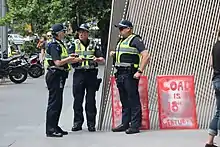
Operational and station/office dress

Equipment is carried by officers in a nylon equipment belt, also known as a gun or weapon belt. The nylon belt, specifically designed to be very light-weight, was first issued in 2003 as a replacement for worn leather belts. The belt consists of one firearm holster placed on the hip (either side), one firearm magazine pouch, one ASP (baton) pouch, one OC Spray pouch, one hand cuff pouch and one holder for the portable radio.
Victoria Police started a roll-out of a new uniform design in June 2013 for sworn members, protective service officers, reservists and recruits. The new uniform was the first time in over thirty years Victoria Police had significantly changed their uniform, which at the time of replacement could be worn in over eighty different combinations.[72] The new design can be worn in either an operational or station/office dress configuration.
Other holsters can be added to the belt to suit members duties such as a clip to hold the polycarbonate baton or mag light. In 2007/08, the chief commissioner approved the issue of firearm holsters which could be strapped around the members thighs, to replace the low-riding belt gun holster. These holsters are not standard issue but are issued to members upon request, and are commonly requested by members who suffer from back aches (as a result of heavy utility belt), or those who find it more operationally sound to draw their firearms from a lower position (as this option offers a more comfortable reach).
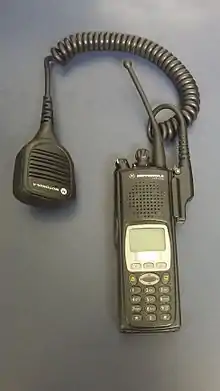
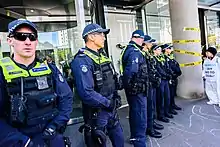
Operational Dress of Victoria Police consists of navy blue cargo/tactical pants, a navy blue long/short sleeved undergarment or shirt, an integrated operational equipment vest (IOEV), a navy blue baseball cap or a wide Brimmed hat (common in rural areas) and black boots. When police members or protective service officers are assigned to duties where they are required to be easily identified, or for occupational health and safety reasons, a high-visibility yellow cover may be put on the IOEV. In 2018, a new style of ballistic vest was announced.[73]
Station/office dress consists of navy blue trousers, navy blue long or short sleeved shirts (which can be worn either open-neck or with a tie), navy blue peaked hat and black boots/shoes.
Some specialist units of Victoria Police, such as the Air Wing, Public Order Response Team, Critical Incident Response Team, Search and Rescue Squad and the Special Operations Group, wear uniforms which are customised to their specialist roles.
Operational safety equipment
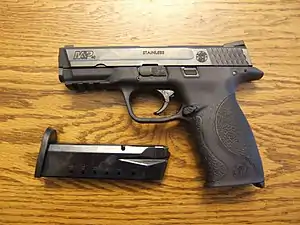
Officers are issued with the Smith and Wesson M&P semi-automatic pistol and also carry an ASP brand 21-inch expandable baton, Oleoresin Capsicum (OC) Spray, handcuffs and small torch. The vast majority of officers carry a Motorola brand portable radio (with or without handpiece) for use on either the Metropolitan Mobile Radio (MMR) or Regional Mobile Radio (RMR) network.
In the 1970s, officers were trained to use the FN Model 1910 .32 semi-automatic pistol which they could carry concealed in their tunic.[74][75] In 1979, Victoria Police began replacing the Model 1910 with the Smith & Wesson Model 10 revolver.[74][75] By the mid-1980s, all officers were routinely openly carrying a revolver.[74]
In the mid-2000s, Victoria Police was set to become the last police service in Australia still using a revolver. Chief Commissioner Christine Nixon was reluctant to transition to a modern semi-automatic pistol. The Bracks Labor government was convinced by the police association and made an election policy for the 2006 Victorian state election to allocate $10 million in funding which would also cover equipping all police cars with tasers.[27][76][77]
Nixon was placed in a precarious position as police operational decisions including equipment are made independent of government. In September 2007, months after the Bracks labor government had been re-elected, Nixon set up an Independent Expert Advisory Panel to advise her if the revolver needed replacing.[78] In March 2008, the panel recommended to replace the revolver with a self-loading pistol.[78][77] In May 2008, a police officer was shot in the leg during a violent shootout in which he had to re-load his revolver. The police association erroneously informed the media the officer had been shot whilst re-loading and called for semi-automatic pistols.[79]
On 6 June 2008, Nixon announced that Victoria Police would upgrade to semi-automatic pistols and would not be equipping officers with tasers.[80][77] On 29 April 2010, Victoria Police announced that the M&P40 semi-automatic pistol with a tactical light had been selected to replace the revolver.[81] The roll-out of the new personal issue firearm commenced in November 2010 with all officers required to complete a four-day training course over 18 months.[75][82]
On 19 December 2019, Victoria Police announced the purchase of 300 Daniel Defense DDM4V7S semi-automatic rifles.[83][84][85] The rifles will be issued to the Public Order Response Team (PORT) and four 24-hour regional uniform stations – Geelong, Ballarat, Morwell and Shepparton to be securely stored in vehicles.[83][84] Over 700 Victoria Police officers are to be trained in the use of the rifles to be able to respond to critical incidents. The roll-out of the rifles will commence in June 2020 and will be completed by the end of 2021.[83] The Special Operations Group (SOG) and the Critical Incident Response Team (CIRT) are both issued with the SIG MCX SBR rifle and a variety of shotguns.[86]
Fleet
Victoria Police's fleet comprises a wide range of different vehicles including Mercedes, Volkswagen, Hyundai, BMW, Tesla and more. In 2018/19 Victoria Police introduced a revamp to their highway patrol fleet, which previously contained mainly Holden VFs. During the revamp, State Highway Patrol was also announced. SHP is the same as Highway Patrol, but it does have a different design as well as few different types of cars, including the Tesla Model X. SHP is not seen all that often as they are used more predominantly in non-metropolitan areas. Victoria Police's general duties fleet now mainly uses SUVs including the new Volkswagen Tiguan, Kia Sorento, Hyundai Santa Fe and Toyota Kluger. They also use 4WDs in rural areas Toyota LandCruiser Prado, Mitsubishi Pajero and Holden Colorados. VICPOL's main frontline response vehicle is their divisional 'divi' van. The first 'modern' version of this unit started out as a Holden Ute based on the 2010 Holden Omega.[87] Announced in 2010, VICPOL partnered with Holden to bring 200 of these vehicles to replace the old, aging divi van fleet of 160 cars, bringing an extra 40 divisional vans to VICPOL's fleet. Most VICPOL stations across the state have at least one divisional van including other general duties and specialist vehicles. In 2021, Victoria Police announced a new Divisional van to join the fleet, the Ford Ranger (see below). The new Ford Ranger includes numerous new safety features including CCTV cameras all over the van, including in the prisoner compartment, where police officers can monitor the prisoner at all times by flicking a switch on the rearview mirror.[88] Malvern and Maryborough were the first stations to receive the new van, VICPOL said it would take 14 months to replace the entire fleet of the older Holden Colorado divi vans announced in 2018. VICPOL will now be replacing these vehicles every three years. On 7 March 2014, the Water Police purchased a new catamaran vessel. The $1.9 million, 14.9-metre-long boat will assist in the search for people stranded at sea or washed overboard and during periods of total darkness, poor light and rough seas. The vessel has the ability to scan the seabed for sunken vessels, and a radar can be switched into heat seeking mode to help locate a person at night, or in situations of poor visibility and rough conditions.[89]
_Evoke_sedan%252C_Victoria_Police_(2015-01-02).jpg.webp) 2014 Holden Commodore Evoke
2014 Holden Commodore Evoke Holden "Divisional Van"
Holden "Divisional Van" Ford Ranger "Divisional Van"
Ford Ranger "Divisional Van"
_Leonardo_Helicopters_AW139_at_Wagga_Wagga_Airport_(6).jpg.webp) AgustaWestland AW139
AgustaWestland AW139.jpg.webp) Police boat
Police boat
Training facilities
The main training for Victoria Police during the first 31 weeks, until a member becomes fully operational, is done at Victoria Police Academy.
Academy facility upgrade[89]
In order to increase the Academy's capacity to accommodate the training of an additional 1700 police and 940 PSOs by November 2014, $15.4 million was provided to Victoria Police to upgrade the Victoria Police Academy in 2013–14.
The significant works include:
- an operational tactics and safety training complex with a new firing range, a ‘soft fall’ area for conducted energy device and defensive tactics training, and a simulator, which will be used for firearm and operational safety training, using bluetooth technology
- a new training system, called Hydra, which simulates a variety of operational scenarios, ranging from vehicle intercepts to large-scale criminal investigations and emergencies, such as bushfires
- a railway platform for PSO training, new classrooms for training, improvements to bathroom and change room facilities, a dining room upgrade and extra car parking space
New operational tactics and safety training (OTST) facility
Construction of a new police training facility alongside the new Victorian Emergency Management Training Centre in Craigieburn commenced in 2013–14.[89]
The new $30 million Victoria Police OTST facility will replace the existing facility located at Essendon Fields, and was due for completion in March 2015.
The new facility will house administration and training staff and include a specially-designed indoor firing range, scenario training village, classrooms, an auditorium, conference centre and fitness facilities. Police will be required to undertake compulsory training twice a year at the facility.
Demographics
| Rank | Males | Females |
|---|---|---|
| Police | 73.7% | 26.3% |
| Recruits | 50.5% | 49.5% |
| Reservists | 25% | 75% |
| PSOs | 90.7% | 9.3% |
| Total sworn | 74.9% | 25.1% |
| Public servants | 32.7% | 67.3% |
| Total workforce | 67.6% | 32.4% |
| Age grouping (years) | Police | Recruits | Reservists | PSOs | Public servants |
|---|---|---|---|---|---|
| <25 | 3.8% | 31.8% | 13.3% | 5.5% | |
| 25–34 | 26.3% | 44.9% | 41.9% | 26.5% | |
| 35–44 | 31% | 19.6% | 22.5% | 24.1% | |
| 45–54 | 29.6% | 3.7% | 16.7% | 24.8% | |
| 55–64 | 9.1% | 50% | 5.1% | 17% | |
| 65+ | 0.3% | 50% | 0.6% | 2% | |
| Total workforce | 76.1% | 0.6% | 0% | 7.4% | 16.% |
Fatal police shootings
From 1990 to 2004, Victorian police accounted for 38% of fatal police shootings in Australia. Victoria police were also responsible for 2 fatal police shootings between 2008 and 2011.[91]
Officers killed on duty
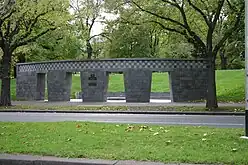

As of 2020, 170 Victoria Police officers have died in the line of duty,[92] including:
- 13 July 1979, Detective Senior Constable Robert Lane was shot and killed while performing a routine interview. Lane was the first officer to be slain on duty since the end of the Vietnam War.[93]
- 27 March 1986, Constable Angela Taylor was killed in the Russell Street Bombing. Taylor was the first female police officer killed in the line of duty in Australian history.[93]
- 12 October 1988, officers Steven Tynan and Damian Eyre were gunned down in the Walsh Street police shootings.[93]
- 16 August 1998, officers Gary Silk and Rodney Miller were gunned down in the Silk–Miller police murders.[93]
- 24 April 2005, officer Anthony 'Tony' Clarke was shot with his own revolver by a drunk driver whom he had pulled over for an RBT. Clarke is the 30th and most recent member of the Victoria Police to have been feloniously slain whilst in the line of duty.[93]
- 22 April 2020, Leading Senior Constable Lynette Taylor, Senior Constable Kevin King, Constable Glen Humphris and Constable Josh Prestney were speaking to the driver of a Porsche 911 for speeding on the Eastern Freeway, near Kew, when they were fatally struck by a truck (driven by a drugged driver) that had veered into the emergency lane where they were standing. The incident marked the worst loss of life in a single incident for the force.[94][95]
- 8 April 2022, Senior Constable Bria Joyce died after a civilian vehicle crashed into her unmarked police vehicle.[96]
Memorials to officers killed on duty are maintained at the Chapel of Remembrance within the main chapel of the Victoria Police Academy at Glen Waverley in the eastern suburbs of Melbourne. There is also a memorial to police officers who have died on duty in Kings Domain, Melbourne, as well as the National Police Memorial in Canberra. Online Honour Rolls are maintained on the Victoria Police website:
See also
- Australian native police
- Victoria Police Special Operations Group
- Victoria Police Search and Rescue Squad
- Victoria Police Air Wing
- Critical Incident Response Team
- Victoria Police Public Order Response Team
- Victoria Police Pipe Band
- Victoria Police Academy
- Corrections Victoria
- Office of Police Integrity
- Project Griffin
- Police misconduct
- Crime in Melbourne
References
- "Victoria Police Employee numbers Dec 2019" (PDF). Victoria Police. December 2019. Retrieved 22 May 2020.
- "Annual Report 2021-2022" (PDF). Victoria Police. 30 August 2022. Retrieved 3 October 2022.
- "Victorian Government Directory". Victorian Government. Retrieved 30 October 2016.
- "Victoria Police Organisation Chart" (PDF). Victoria Police. 8 July 2020. Retrieved 20 July 2020.
- "Victoria Police Boundaries". Victoria Police. Retrieved 30 October 2016.
- "About Victoria Police". Victoria Police. Victoria Police. 16 October 2014. Archived from the original on 29 August 2016. Retrieved 30 August 2016.
- "Victoria Police Act 2013" (PDF). Legislation Victoria. Government of Victoria. 20 April 2016. Retrieved 30 August 2016.
- "Annual Report 2018–2019" (PDF). Victoria Police. 3 October 2019. Retrieved 22 May 2020.
- "What is the northern boundary of Victoria?". The Age. 21 April 1906. Archived from the original on 15 September 2009.
- Street, B. A. (1954), "Port Phillip – 1840–1850 Part II", Victorian Historical Magazine, 26 (102): 45, retrieved 29 August 2013
- Palmer, Darren. A new police in Victoria: conditions of crises or politics of reform? [150 Years of the Victoria Police. Published jointly by the Royal Historical Society of Victoria and the Victoria Police Historical Society.] [online]. Victorian Historical Journal (1987), v.74, no.2, Oct 2003: 167–196. Availability: <http://search.informit.com.au/fullText;dn=200312168;res=APAFT> ISSN 1030-7710. [cited 29 Aug 13].
- "VICTORIA". South Australian Register. Adelaide: National Library of Australia. 22 January 1853. p. 3. Retrieved 29 August 2013.
- 5426_vpo_policelife_winter15_fa_dig
- "FURTHER PARTICULARS OF THE BALLAARAT AFFRAY". The Argus. Melbourne: National Library of Australia. 5 December 1854. p. 4. Retrieved 29 August 2013.
- Charles MacMahon, Australian Dictionary of Biography, Volume 5, MUP, 1974.
- "Victoria Police 1800–1899 Honour Roll". Victoria Police. 20 September 2012. Retrieved 29 August 2013.
- "Victoria Police History". Victoria Police. 2 December 2010. Retrieved 29 August 2013.
- "THE POLICE MURDERS". The Argus. Melbourne: National Library of Australia. 30 October 1878. p. 6. Retrieved 29 August 2013.
- "THE POLICE MURDERS". The Argus. Melbourne: National Library of Australia. 5 November 1878. p. 6. Retrieved 29 August 2013.
- "LATEST NEWS". The Camperdown Chronicle. National Library of Australia. 29 June 1880. p. 2. Retrieved 30 August 2013.
- "THE VICTORIAN POLICE GUIDE". Bendigo Advertiser. Vic.: National Library of Australia. 20 August 1888. p. 3. Retrieved 30 August 2013.
- "Police Franchise". The Independent. Footscray, Vic.: National Library of Australia. 17 November 1888. p. 2. Retrieved 30 August 2013.
- "The Victoria Police Valour Award". Victoria Police historical Society. Retrieved 29 August 2013.
- "VICTORIA". The Chronicle. Adelaide: National Library of Australia. 15 November 1902. p. 16. Retrieved 30 August 2013.
- "The WOMEN Who CHASE CRIMINALS". The Australian Women's Weekly. Vol. I, no. 36. Australia. 10 February 1934. p. 15. Retrieved 31 August 2018 – via National Library of Australia.
- Woolley, Colleen. "'Connor, Madge Irene (1874–1952)'". Australian Dictionary of Biography. National Centre of Biography, Australian National University. ISSN 1833-7538. Retrieved 31 August 2018.
- Murphy, Mathew; Petrie, Andrea; Munro, Ian; Tomazin, Farrah (15 November 2006). "New lethal weapons for police". The Age. Melbourne.
- Mannix, Liam (1 June 2015). "Victoria Police edits Wikipedia page of police shooting victim Tyler Cassidy". The Age. Melbourne: Fairfax Media. Retrieved 6 August 2015.
- Illingworth, Simon (2006). Filthy Rat : One Man's Stand Against Police Corruption and Melbourne's Gangland War (2nd ed.). Fremantle, W.A.: Fontaine Press. ISBN 978-0-9804170-4-3.
- "Former judge says Vic police are corrupt". The Sydney Morning Herald. 11 January 2007.
- "Simon Overland replaces Christine Nixon as Victorian police chief commisioner". www.news.com.au. 2 March 2009. Archived from the original on 6 March 2009. Retrieved 30 March 2023.
- "Overland denies he quit over crime stats". ABC News. 16 June 2011. Retrieved 30 August 2016.
- Millar, Paul (16 June 2011). "Old-school policeman takes on 'daunting' job". The Age. Retrieved 30 August 2016.
- McKenzie, Richard Baker and Nick (3 May 2011). "Corruption warning over handling of crime stats". The Age. Retrieved 30 August 2016.
- "Protesters arrested as chaos descends on CBD". The Age. The Age. 22 October 2011.
- "Victoria Police Chief Commissioner Ken Lay steps down". The Age. Rania Spooner, Tammy Mills. 29 December 2014. Retrieved 30 December 2014.
- "Graham Ashton appointed Chief Commissioner of Victoria Police". ABC News. 25 May 2015. Retrieved 25 May 2015.
- Andreou, Helen (22 April 2016). "Police". www.budget.vic.gov.au. Retrieved 29 April 2016.
- "About the review". www.victorianhumanrightscommission.com. Retrieved 30 August 2016.
- "Human Rights Commission". Human Rights Commission. Human Rights Commission. December 2015. Retrieved 30 August 2016.
- "Victoria Police chief apologises over damning sexual harassment findings". ABC News. 8 December 2015. Retrieved 30 August 2016.
- "'Unprecedented': Victoria to boost police force by 20 per cent". ABC News. 4 December 2016. Retrieved 22 October 2018.
- "Fake breath tests cost Vic Police funding". NewsComAu. Retrieved 8 June 2018.
- "Victoria Police lose $4m in funding over faked roadside breath tests". ABC News. 30 May 2018. Retrieved 8 June 2018.
- Wahlquist, Calla (3 December 2018). "Victoria calls royal commission into underworld lawyer scandal". the Guardian. Retrieved 24 December 2022.
- Ratliff, Evan (16 January 2020). "The Mysterious Lawyer X". The California Sunday Magazine. Retrieved 21 March 2022.
- "AB (a pseudonym) v CD (a pseudonym); EF (a pseudonym) v CD (a pseudonym) [2018] HCA 58". Austlii. High Court. 5 November 2018. Retrieved 21 May 2023.
- "From military-style to navy blue threads: the evolution of the Victoria Police uniform". Retrieved 31 August 2016.
- "Magazine of Victoria Police Uniform History" (PDF). Victoria Police History. Victoria Police Historical Society Inc. 2 November 2009. Retrieved 1 September 2016.
- Bucci, Nino (5 December 2012). "Dark blue hue a police winner". The Age. Retrieved 31 August 2016.
- "The Age – Google News Archive Search". news.google.com. Retrieved 31 August 2016.
- Archbold, Carol (2013). "Section 1 History of the Police". Policing : a text/reader (PDF). Thousand Oaks, Calif.: SAGE Publications. p. 4. ISBN 9781412993692. Retrieved 20 July 2020.
- "Section 13 Rank - Victoria Police Act 2013 Rank Structure". Austlii Classic. Retrieved 26 November 2019.
- "Victoria Police (Police Officers, Protective Services Officers, Police Reservists and Police Recruits) Enterprise Agreement 2019" (PDF). Fair Work Commission. 25 May 2020. Retrieved 20 July 2020.
- "The Police Association Victoria – First Constable (63/11)". The Police Association of Victoria (Press release). 29 November 2011. Retrieved 30 August 2016.
- Robinson, Paul; Hill-Douglas, Olivia (29 October 2001). "Last-minute deal brings police pay dispute to end". The Age. Archived from the original on 25 February 2003. Retrieved 20 July 2020.
- Campbell, Sarah (October 2008). "Retirement of a Reservist". Police life: the Victoria Police magazine. Melbourne: Victoria Police. p. 9. ISSN 0032-2598. Archived from the original on 2 June 2009.
- "Victoria Police – The rank and file". Victoria Police. Victoria Police. 2 December 2010. Archived from the original on 11 October 2007.
- "Victoria Police Association Journal". December 2014.
{{cite journal}}: Cite journal requires|journal=(help) - "Victoria Police career webstite".
- "Becoming a Police Officer". Victoria Police Careers. Archived from the original on 25 August 2016.
- Police, Victoria. "Victoria Police – Protective Services Officers (PSOs)". www.police.vic.gov.au. Retrieved 27 December 2016.
- Police, Victoria. "Victoria Police – Transit and Public Safety". www.police.vic.gov.au. Retrieved 27 December 2016.
- "June 2010 – Public safety edition". Victoria Police. June 2010. Retrieved 27 December 2016.
- Victoria Police Honours & Awards, Victoria Police. Retrieved 1 December 2010.
- Australian Bravery Decorations Archived 19 September 2010 at the Wayback Machine, Awards and Culture Branch, Department of Prime Minister and Cabinet. Retrieved 1 December 2010.
- Australian Police Medal, Awards and Culture Branch, Department of Prime Minister and Cabinet. Retrieved 1 December 2010.
- Police Overseas Service Medal, Awards and Culture Branch, Department of Prime Minister and Cabinet. Retrieved 1 December 2010.
- Humanitarian Overseas Service Medal Archived 21 December 2010 at the Wayback Machine, Awards and Culture Branch, Department of Prime Minister and Cabinet. Retrieved 1 December 2010.
- National Medal, Awards and Culture Branch, Department of Prime Minister and Cabinet. Retrieved 1 December 2010.
- Public Service Medal, Awards and Culture Branch, Department of Prime Minister and Cabinet. Retrieved 1 December 2010.
- [HS-NewUniform]. 14 June 2013. Retrieved on 15 October 2013.
- "Police reveal new ballistic vests". www.police.vic.gov.au.
- Blue Army by Jude McCulloch at Google Books
- Carnovale, Maria. "Police aim high with semi-autos". Police Life - the Victoria Police magazine. Victoria Police. ISSN 0032-2598. February 2011. Retrieved 26 December 2019.
- "Semi-Automatic Pistols : A case for change" (PDF). Journal : The Police Association Victoria. Melbourne. June 2007. ISSN 1443-2307. Archived from the original (PDF) on 21 July 2008.
- Burgess, Matthew (6 June 2008). "Semi-automatic weapons move a victory, says police union". The Age. Melbourne. Retrieved 27 July 2011.
- Expert Advisory Panel (March 2008). Standard Issue Handgun for Victoria Police (Report). Archived from the original on 20 February 2011.
- "Shot policeman wasn't reloading when hit". The Sydney Morning Herald. 15 May 2008. Retrieved 25 December 2019.
- "Police set to move to semi-automatic weapons". Victoria Police (Press release). 6 June 2008. Archived from the original on 23 July 2008.
- "Police award tender for semi-automatic firearms". Victoria Police (Press release). 29 April 2010. Archived from the original on 2 May 2010.
- Minister for Police & Emergency Services (15 October 2010). "Police Roll Out The First 3000 Semi-Automatic Guns". Department of Justice (Press release). Archived from the original on 31 March 2011. Retrieved 25 December 2019.
- "New rifles to respond to critical incidents". Victoria Police (Press release). 19 December 2019. Archived from the original on 18 December 2019.
- Patton, Deputy Commissioner Shane (18 December 2019). New rifles to respond to critical incidents (Television production). Victoria Police. Retrieved 26 December 2019.
- Minister for Police and Emergency Services (17 February 2019). "New Police Firepower To Target Major Incidents". Premier of Victoria. Retrieved 25 December 2019.
- Critical Incident Response Team (Television production). Victoria Police. 16 April 2019. Archived from the original on 22 December 2021. Retrieved 21 November 2019.
- "Holden And Victoria Police Launch New 2010 Holden Commodure Ute Divisional Van". 15 September 2009.
- Archived at Ghostarchive and the Wayback Machine: "Victoria Police's new fleet of divvy vans | 7NEWS". YouTube.
- "Annual Report 2013-2014". Victoria Police. 30 June 2014. Retrieved 30 October 2016.
- "Victoria Police – Annual report 2016". Victoria Police. Victoria Police. Retrieved 30 October 2016.
- Goldsworthy, Terry (25 November 2014). "Shoot to kill: the use of lethal force by police in Australia". The Conversation. Retrieved 27 September 2021.
- "Blue Ribbon Day 2020". Victoria Police Blue Ribbon Foundation. 7 September 2020. Retrieved 11 March 2021.
- "Victoria Police 1950–1999 Honour Roll". Victoria Police. 9 January 2013. Retrieved 29 August 2013.
- "Victoria Police names officers killed in Eastern Freeway truck crash in Melbourne". ABC News. 23 April 2020. Retrieved 11 March 2021.
- Chapman, Alex; Olle, Emily (23 April 2020). "Eastern Freeway crash: Porsche driver Richard Pusey was out on bail before tragic crash". 7News. Retrieved 11 March 2021.
- "Man's harrowing last words before fatal collision with police car". 11 April 2022.
Further reading
- Haldane, Robert (2018) [1986]. The People's Force. Melbourne: Melbourne University Press. ISBN 978-0-522-87335-1. OCLC 1089007018.
- 1853-2003, Victoria Police Australia : celebrating 150 years in the community. Marilyn Miller, Keith Dunstan, Christine Nixon, Victoria Police. Melbourne: Victoria Police. 2003. ISBN 0-9581712-0-3. OCLC 223404154.
{{cite book}}: CS1 maint: others (link)
